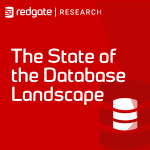Four steps towards tackling the complexity of managing multiple database platforms
The 2024 State of the Database Landscape survey showed that 79% of businesses are now using two or more database platforms (vs 62% in 2020). Businesses revealed that this growth was largely due to the differing use cases across each platform, as well as the need to increase flexibility.
Despite these recognized benefits, increasing the diversity of your database platforms can bring its own set of challenges, including skillset requirements, data integration complexities, security, and monitoring.
So, how can database professionals overcome these challenges?
Here are four key steps to take towards multi-database platform simplicity:
Step 1: Maximize the benefits of the cloud
Cloud-based technologies offer a more streamlined and simplified approach to managing multiple databases, alleviating many of the complexities linked to on-premises solutions.
Such complexities include the burden of dealing with disparate versions, which cloud offerings can eliminate – meaning you are always up-to-date. Additionally, precious time can be saved and upkeep responsibilities reduced by setting the maintenance schedule for patches, and managing all database platforms in the same way.
When it comes to staff changes – which are challenging in any context – cloud tech can help here, too, by providing standardized tools and infrastructure. Plus, tasks such as building pipelines and managing DevOps can be simplified, ultimately creating a more viable situation across the board.
(When working on-prem) sometimes it’s very hard because you’re writing a lot of custom code. If a resource leaves and someone else comes in, there’s a huge learning curve to pick it up. Whereas, if it is a technology which stays in cloud, it’s so much easier and linear to manage.
Mri Pandit, Senior Manager at Navy Federal Credit Union.
Step 2: Upskill your team and make smart hires
Having the right people on your team is crucial when it comes to managing multiple database platforms – not only to reduce risk but to enable upskilling and knowledge-sharing between peers.
For example, having experts in each database platform at your disposal is hugely beneficial. However, to ensure your team is as multi-skilled as possible, it’s important to have a process and platform for knowledge-sharing in place. Without standardizing and sharing an individual’s skills across the department, you’re creating a single point of failure.
In some cases, skills need real-world scenarios to play out for team members to learn. Use examples of previous issue reviews and ‘roleplay’ them to see what approach the team would take in that situation.
When it comes to ‘smart’ hires, these are times when you may need to bring in new talent with knowledge of a new database platform. Be sure to think long-term here, and ask questions of them. Are they open to change, passionate about learning, and would they be willing to cover multiple database platforms with training?
Finally, it’s important to track – and celebrate – the upskilling of your team members. The benefits to your company are obvious, but these are also pivotal points in an individual’s career and their own personal growth!
You’re not trying to find somebody who is an expert at all things – you are looking for willingness to teach and willingness to learn.
Joshua Higginbotham, Senior Architect at Centric Consulting.
Step 3: Adopt a true end-to-end Database DevOps approach
By implementing a DevOps approach and utilizing its full range of benefits, you can greatly simplify the complexity of managing multiple database platforms. For a start, it encourages the standardization of processes across teams working on different platforms, which fuels collaboration and simplifies reporting.
DevOps also utilizes automation to reduce the time spent on manual tasks across different platforms – freeing-up time for the team to be able to concentrate on more valuable matters such as knowledge-sharing, training and working on more advanced tasks.
Elsewhere, it can ensure teams are monitoring your cross-database, multi-platform estate as ‘one’, in a central location, to encourage optimal performance and enhance team collaboration.
(Database complexity) is a key driver for automation and trying to find ways to increase simplicity and reduce the risk of manual errors.
David Gummer, Chief Product Officer at Redgate Software.
Watch the full interview with David here
Step 4: Consider third-party tools for assistance
Complementary third-party tools are worth considering because, when chosen correctly, they can allow you to condense the management of multiple database platforms into one place.
However, it’s important to analyze your end-to-end tool suite before adding anything new into the mix. Ask yourself these questions: how well do the tools fit together, where are the gaps and – most importantly – are you introducing simplicity, or in fact creating more complexity?
These tools can help take away the initial alert and investigation across your estate – you can allow them to diagnose before spending your own precious time taking further action. In turn, this frees-up more time for a team to focus on advanced maintenance and troubleshooting operations.
There are things that you can do to help – have a unified maintenance solution or monitoring solution to make that easier on your teams.
Joshua Higginbotham, Senior Architect at Centric Consulting.
Interested in learning more? Catch the full discussion between Mri, Steve and Joshua, and their experience in managing multiple database platforms here.
Want to learn more about how Redgate tools can help overcome complexity? Visit our solutions page.
Read next
Blog post
Revealing the State of the Database Landscape
Four months ago, we launched our State of the Database Landscape survey to discover what’s happening in the industry, and why. We asked questions such as which databases are developers now using, how many, and why? What are the challenges when introducing database DevOps? How is cloud usage and adoption evolving? Is AI changing database
Blog post
7 Essential Factors for a Successful Cloud Migration: A Non-Technical Guide
Are you looking to modernize and migrate your data but have questions about the complex organizational challenges? We recently hosted the webinar: Overcoming Organizational Challenges in Data Modernization and Cloud Migration: A Guide for Senior IT Leaders. Featuring industry experts Matt Gordon and Dustin Dorsey, there was a wealth of information packed into this hour-long

